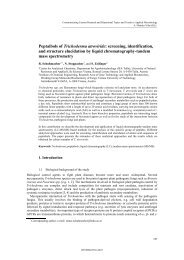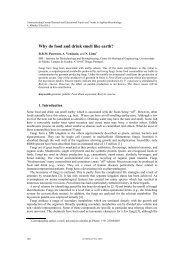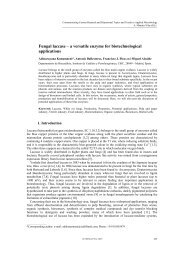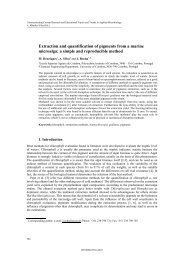Atomic Force Microscope Nanoindentations to Reliably Measure the ...
Atomic Force Microscope Nanoindentations to Reliably Measure the ...
Atomic Force Microscope Nanoindentations to Reliably Measure the ...
Create successful ePaper yourself
Turn your PDF publications into a flip-book with our unique Google optimized e-Paper software.
Modern Research and Educational Topics in Microscopy.<br />
_______________________________________________________________________________________________<br />
©FORMATEX 2007<br />
A. Méndez-Vilas and J. Díaz (Eds.)<br />
Unlike <strong>the</strong> Oliver and Pharr procedure, we did not use <strong>the</strong> equations for <strong>the</strong> contact between an<br />
ideally sharp cone and an elastic half space. The reason for this choice can be easily found by recalling<br />
that a real indenter cannot be considered <strong>to</strong> be ideally sharp, since rounding is unavoidable on <strong>the</strong> very<br />
first nanometres of <strong>the</strong> apex because of manufacturing technological constraints.<br />
An alternative uses a dimensional analysis of <strong>the</strong> indentation quantities[24] involved in a conical<br />
indentation of an elastic-plastic material with strain hardening which, for indentations in <strong>the</strong> nanometer<br />
scale, must introduce a length scale for apex rounding. The following dimensionless equation can <strong>the</strong>n be<br />
derived:[24]<br />
F ⎡ l σ ⎤<br />
Y<br />
= Π⎢<br />
, , n,<br />
θ<br />
2<br />
⎥<br />
(9)<br />
Esample<br />
p ⎢⎣<br />
p Esample<br />
⎥⎦<br />
making <strong>the</strong> exponent, which scales <strong>the</strong> applied load and <strong>the</strong> penetration depth, <strong>to</strong> deviate from two. The<br />
strain hardening exponent n, <strong>the</strong> sample Young’s modulus Esample, <strong>the</strong> yield stress σY, <strong>the</strong> indenter<br />
opening angle θ and <strong>the</strong> length scale l are <strong>the</strong> relevant quantities in equation 9. The length scale l can be<br />
identified by modelling <strong>the</strong> tip as a paraboloid of revolution, which, in cylindrical coordinates, is<br />
described by<br />
2<br />
ρ = 4qz<br />
where q is a constant proportional <strong>to</strong> <strong>the</strong> curvature. In this case <strong>the</strong> length scale is represented by <strong>the</strong><br />
curvature radius at <strong>the</strong> apex which, from equation 10, is equal <strong>to</strong> 2q.<br />
The solution for <strong>the</strong> elastic contact, given by Sneddon[20] satisfies both, <strong>the</strong> need <strong>to</strong> introduce a length<br />
scale and an exponent smaller than two in<br />
( ) 2 / 1 3<br />
2 2<br />
4E<br />
F = qp<br />
(11)<br />
3(<br />
1−ν<br />
)<br />
showing that <strong>the</strong> load scales with <strong>the</strong> penetration depth with an exponent of 1.5. Since <strong>the</strong> Sneddon<br />
<strong>the</strong>ory deals with an elastic contact, it adequately describes <strong>the</strong> force curve in <strong>the</strong> case of <strong>the</strong> PPG rubber<br />
while it fails <strong>to</strong> do so for <strong>the</strong> elastic-plastic material, i.e. lead (see Fig. 7). As expected, <strong>the</strong> two force<br />
curves show different slopes in a logarithmic plot of <strong>the</strong> penetration depth vs. applied load: almost equal<br />
<strong>to</strong> 1.5 for <strong>the</strong> PPG rubber and 2 (as predicted for an elastic-plastic contact[25]) for lead. Moreover, <strong>the</strong><br />
plots are linear, confirming power law relations.<br />
Figure 8 finally shows a comparison among <strong>the</strong> Young’s moduli measured through standard tensile tests,<br />
black bars, and <strong>the</strong> Young’s moduli calculated from nanoindentations performed at various piezo<br />
displacement rates. It is clear that <strong>the</strong> evaluated elastic moduli come closer <strong>to</strong> <strong>the</strong> macroscopic value with<br />
increasing loading rates. However, this result is not surprising since mechanical phenomena o<strong>the</strong>r than<br />
744<br />
(10)<br />
Fig. 7 Logarithmic plot of applied load vs.<br />
penetration depth collected on two polymer<br />
samples: a PPG rubber and an iPP sample<br />
solidified at 110K/s. The typical slope of 1.5 is<br />
compared <strong>to</strong> a metal sample, lead, for which a<br />
slope of 2 is measured









